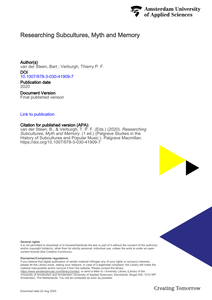This chapter examines how the Berlin neighborhood of eastern Kreuzberg attained its mythical image as a youth culture neighborhood. It combines theories of myth-making and canonization with the concept of preference construction, thereby developing new tools to assess how certain ideas and images (e.g. from youth cultures) come to be collectively preferred and believed as more exceptional or true in spite of similar ones. It argues that through the construction of preferences, people have become invested in Kreuzberg’s historically alternative and contemporary trendsetting images. Through this case study, the chapter shows that youth cultures appeal to people because of their outspoken and elusive nature, something that continually urges people to ask themselves how they relate to them. People thus cultivate preferences when they take a position regarding youth cultures. When people become collectively invested in certain shared ideas and images, subcultural myths are born.
DOCUMENT
This book brings together contributions that analyse how subcultural myths develop and how they can be studied. Through critical engagement with (history) writing and other sources on subcultures by contemporaries, veterans, popular media and researchers, it aims to establish: how stories and histories of subcultures emerge and become canonized through the process of mythification; which developments and actors are crucial in this process; and finally how researchers like historians, sociologists, and anthropologists should deal with these myths and myth-making processes. By considering these issues and questions in relation to mythmaking, this book provides new insights on how to research the identity, history, and cultural memory of youth subcultures.
DOCUMENT

Titel: The Exodus from the Netherlands or Brain Circulation: Push and Pull Factors of Remigration among Highly Educated Turkish Dutch Auteurs: Gürkan Çelik and Ton Notten In: European Review, 22 (3), 2014, pp. 403-413 The exodus from the Netherlands or brain circulation: Push and pull factors of remigration among highly educated Turkish-Dutch An increasing number of Turks, the Netherlands’ largest ethnic minority, are beginning to return to their country of origin, taking with them the education and skills they have acquired abroad, as the Netherlands faces challenges from economic difficulties, social tension and increasingly powerful right wing parties. At the same time Turkey’s political, social and economic conditions have been improving, making returning home even more appealing for Turkish migrants at large. This article gives explanations about the push and pull factors of return migration. The factors influencing return to one’s country of origin are “pulls”. It is assumed that remigration is more affected by positive developments in the country of origin than by negative developments in the country of residence. Civil society, business world and the Dutch government can develop policies to bind these capable people to the Netherlands, at least in the form of “brain circulation” so that they can serve as “bridge builders” between the two countries. Keywords Return migration, integration, Turkish-Dutch, Turkish migrants, brain circulation =============================================================================== SAMENVATTING De uittocht uit Nederland of breincirculatie: Push- en pull-factoren van remigratie onder hoogopgeleide Turkse Nederlanders. In Nederland zien we een lichte toename van het aantal Turken, de grootste etnische minderheidsgroep in Nederland, die terugkeren naar hun land van herkomst. Ze exporteren daarmee goede opleidingen en vaardigheden die ze in Nederland verwierven. De oorzaken: de economische neergang, sociale spanningen en de groeiende invloed van extreemrechtse partijen. Tegelijkertijd verbeteren in Turkije de politieke, sociale en economische omstandigheden die steeds meer aantrekkingskracht uitoefenen op immigranten in dat land. Dit artikel gaat in op de push- and pull-factoren voor remigranten. Pull-factoren beinvloeden iemands terugkeer naar zijn land van herkomst. Aangenomen wordt dat zo’n remigratie sterker wordt bevorderd door positieve ontwikkelingen in het land van herkomst dan door negatieve (push-factoren) in het land waar men op dat moment woont. De civil society, het bedrijfsleven en de Nederlandse overhead kunnen een beleid ontwikkelen dat verdienstelijke inwoners weet te behouden, hen op z’n minst kan inschakelen als bruggenbouwers en aldus kenniscirculatie mogelijk maakt tussen beide landen. Trefwoorden Retourmigratie, integratie, Turkse Nederlanders, Turkse migranten, kenniscirculatie, breincirculatie
DOCUMENT
